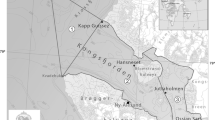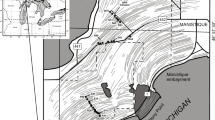Abstract
A four hectare mixed bottomland hardwood site on Ninety Six Creek in the Piedmont of South Carolina near Ninety Six, SC was studied for two years to characterize wetland traits. The soils were thermic Fluventic or Fluvaquentic Dystrochrepts predominantly Shellbluff series and well drained. Overbank flooding occurred on the average of 4 times per year and 1.5 times during the growing season for a 13 year period. High water table levels during the early growing season were related to rainfall events. A hydrologic model (WATRCOM-2D), soils, water table levels, and GIS techniques were used to estimate the portion of the bottom that met wetland criteria similar to those defined in the 1987 and 1989 federal wetland delineation manuals. Less than one hectare met these criteria. The wetland “status” of the vegetation within the bottom and adjacent slope was not correlated with water table levels, predicted wetland areas, or landforms. Wetland traits of the site were closely related to hydric soil traits within the upper 25 cm of the Chewacla and Chenneby soils and landform characteristics. Wetlands in this bottom were primarily driven by local precipitation and not by overbank flooding as originally suspected. Songbirds and small mammals were relatively abundant in the small bottom during the spring and summer of 1992. Protection of only the jurisdictional wetlands in this bottom would not be adequate to sustain riverine functions (conveyor) and to provide wildlife travel corridors between adjacent forested areas.
Similar content being viewed by others
References
An Interagency Cooperative Publication: 1989, Federal manual for identifying and delineating jurisdictional wetlands. U. S. Departments of Army, Fish and Wildlife Service, Environmental Protection Agency, and Soil Conservation Service. January 1989. Superintendent of Documents, U. S. Gov. Printing Office. Washington, DC 20402. 76 pp.
Brinson, M. M.: 1993a, Changes in the functioning of wetlands along environmental gradients. Wetlands 13 No. 2 Special Issue June 1993, pp. 65–74.
Brinson, M. M.: 1993b, A hydrogeomorphic classification for wetlands. US Army Corps of Engineers, Waterways Experiment Station, Vicksburg, MS. Wetlands Research Program Technical Report WRP-DE-4. 79 pp.
Carter, V.: 1990, The Great Dismal Swamp: An illustrated case study, in Forested Wetlands, A. E. Lugo, M. Brinson, and S. Brown (eds.). pp. 201–211. Ecosystems of the World, No. 15, Elservier, New York. p. 527.
Crawford, R. M. M.: 1992, Oxygen availability as an ecological limit to plant distribution. Advances in Ecological Research Vol 23. pp. 93–185. Academic Press Limited, London.
Day, F. P., West, S. K. and Tupacz, E. G.: 1988, The influence of ground-water dynamics in a periodically flooded ecosystem, the Great Dismal Swamp. Wetlands 8:1–13.
Dickson, J. G.: 1978, Forest bird communities of the bottomland hardwoods. pp. 66–73, in R. M. DeGraaf (tech coord). Proc of Workshop: Management of southern forests for nongame birds. USDA Forest Service, Gen. Tech. Rept. SE-14, Asheville, NC. 176 p.
Dickson, J. G. and Warren, M. V.: (in press), Wildlife and fish communities of eastern riparian forests, in Proceedings of Conference: Riparian ecosystems in the humid U. S. Functions, Values, and Management. March 15–18, 1993. Atlanta, GA. Sponsors U. S. Environmental Protection Agency, Fish and Wildlife Service, Department of Agriculture, Soil Conservation Service, and Forest Service; Tennessee Valley Authority and National Association of Conservation Districts.
Dueser, R. D., and Shugart, H. H.: 1978, Microhabitats in a forest-floor small mammal fauna. Ecol. 59:89–98.
Gambrell, R. P. and Patrick, W. H., Jr.: 1978, Chemical and microbiological properties of anaerobic soils and sediments, in Plant Life in Anaerobic Environments, D. D. Hook and R. M. M. Crawford (eds.). pp. 375–423. Ann Arbor Sci., Ann Arbor, MI. 564 p.
Geier, A. R. and Best, L. B.: 1980, Habitat selection by small mammals of riparian communities: evaluating effects of habitat alterations. J. Wild. Manage. 44(1):16–24.
Hanks, R. J. and Ashcroft, G. L.: 1980, Applied Soil Physics Advanced Series in Agricultural Sciences 8. Springer-Verlag, Berlin. 159 p.
Harmon, M. E., Franklin, J. F., Swanson, F. J., Sollius, P. S., Gregory, V., Sattin, J. D., Anderson, M. H., Cline, S. P., Aumeu, N. G., Sedell, J. R., Lieukaemper, G. W., Cromack, K. Jr., and Cummins, K. W.: 1986, Ecology of coarse woody debris in temperate ecosystems. Advances in Ecological Research.
Healy, W. M. and Brooks, R. T.: 1988, Small mammal abundance in Northern hardwood stands in West Virginia. J. Wildl. Manage. 52(3):491–96.
Hodorff, R. A., Sieg, C.H. and Linder, R. L.: 1988, Wildlife response to stand structure of deciduous woodlands. J. Wildl. Manage. 52(4):667–73.
Letey, J. and Stolzy, L. H.: 1964, Measurement of oxygen diffusion rates with the platinum microelectrode. I. theory and equipment. Hilgardia 35:545–554.
Light, T. S.: 1972, Standard solution for redox potential measurements. Analytical Chem. 44:1038–39.
Mc'Closkey, R. T. and LaJoie, D. T.: 1975, Determinants of local distribution and abundance in white footed mice. Ecol. 56:467–72.
Parsons, J. E., Skaggs, R. W. and Doty, C. W.: 1991a, Development and testing of a water management model (WATRCOM): Development. Trans. of the ASAE 34(1):120–128.
Parsons, J. E., Doty, C. W. and Skaggs, R. W.: 1991b, Development and testing of a water management model (WATRCOM): Field testing. Trans. of the ASAE 34(4):1674–1682.
Pearson, P. G.: 1959, Small mammals and old field succession on the Piedmont of New Jersey. Ecol. 40(2): 249–55.
Pritchett, W. L. and Fisher, R. F.: 1987, Properties and Management of Forest Soils. 2nd Edition. John Wiley and Sons. New York. 494 p.
Ralph, C. J., Geupel, G. R., Pyle, P., Martin, T. E. and DeSante, D. F.: 1993, Handbook of field methods for monitoring landbirds. USDA, Forest Service, Pacific Southwest Research Station. Gen. Tech. Rept. PSW-GTR-144, Albany, CA. 41 p.
Reed, P. B.: 1988, National list of plant species that occur in wetlands: Southeast (Reg.2). U. S. Fish and Wildlife Service. Biol. Rept. 88(26.2). 124 p.
Thomas, J. W. (tech. ed): 1979, Wildlife habitats in managed forests, the Blue Mountains of Oregon and Washington. USDA For. Ser. Handb. 553. Washington Off., Washington, DC.
Thornthwaite, C. W.: 1948, An approach toward a rational classification of climate. Geog. Rev. 38:55–94.
Tiner, R. W.: 1991, The concept of a hydrophyte for wetland identification. BioScience 41(4):236–247.
U. S. Army Corps of Engineers (CE): 1991, Charleston District, Regulatory Branch. Personal letter from Don Hill, May 21, 1991.
U. S. Department of Agriculture, Soil Conservation Service: 1980, Soil survey of Greenwood and McCormick Counties, SC. U. S. Government Printing Office 1980-232-310/81. 68 p.
Author information
Authors and Affiliations
Rights and permissions
About this article
Cite this article
Hook, D.D., McKee, W.H., Williams, T.M. et al. Hydrologic and wetland characteristics of a piedmont bottom in South Carolina. Water Air Soil Pollut 77, 293–320 (1994). https://doi.org/10.1007/BF00478424
Issue Date:
DOI: https://doi.org/10.1007/BF00478424




